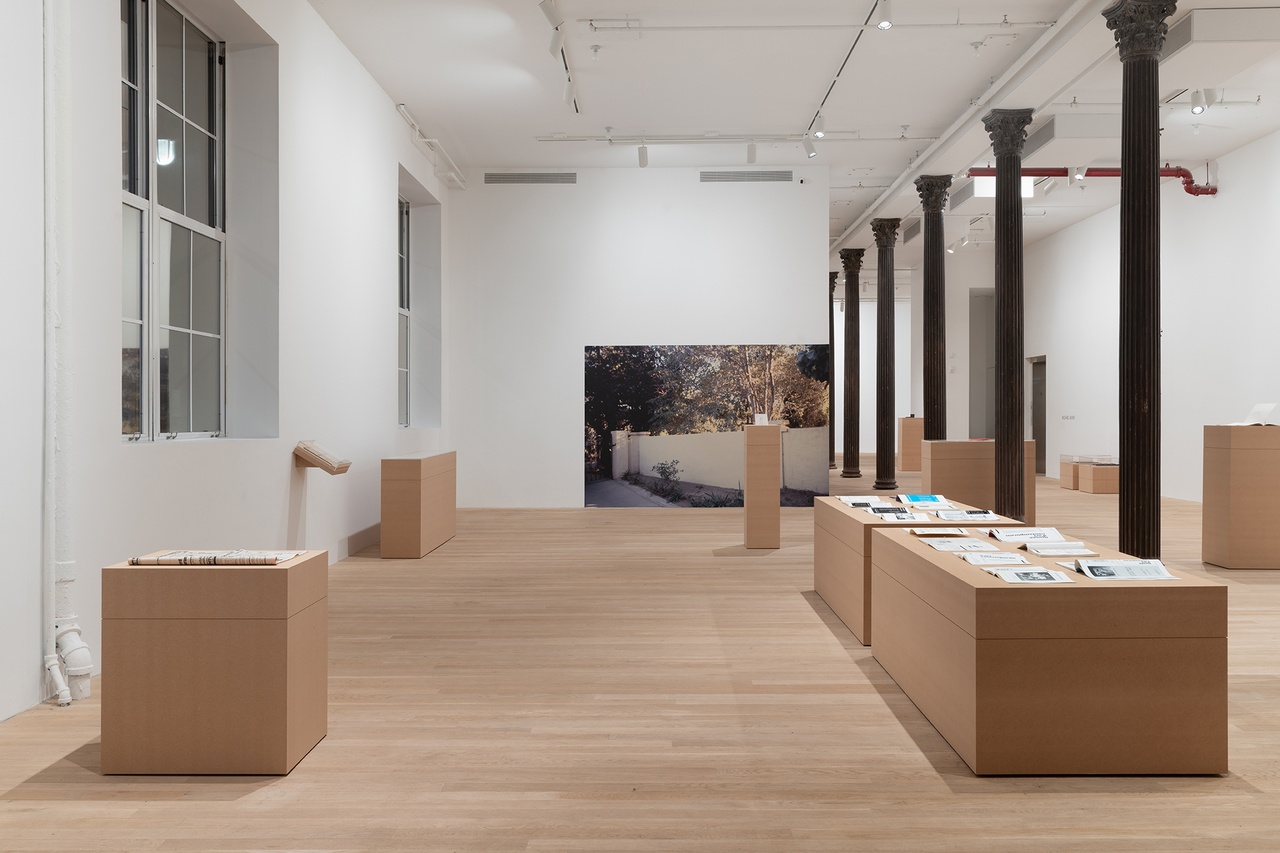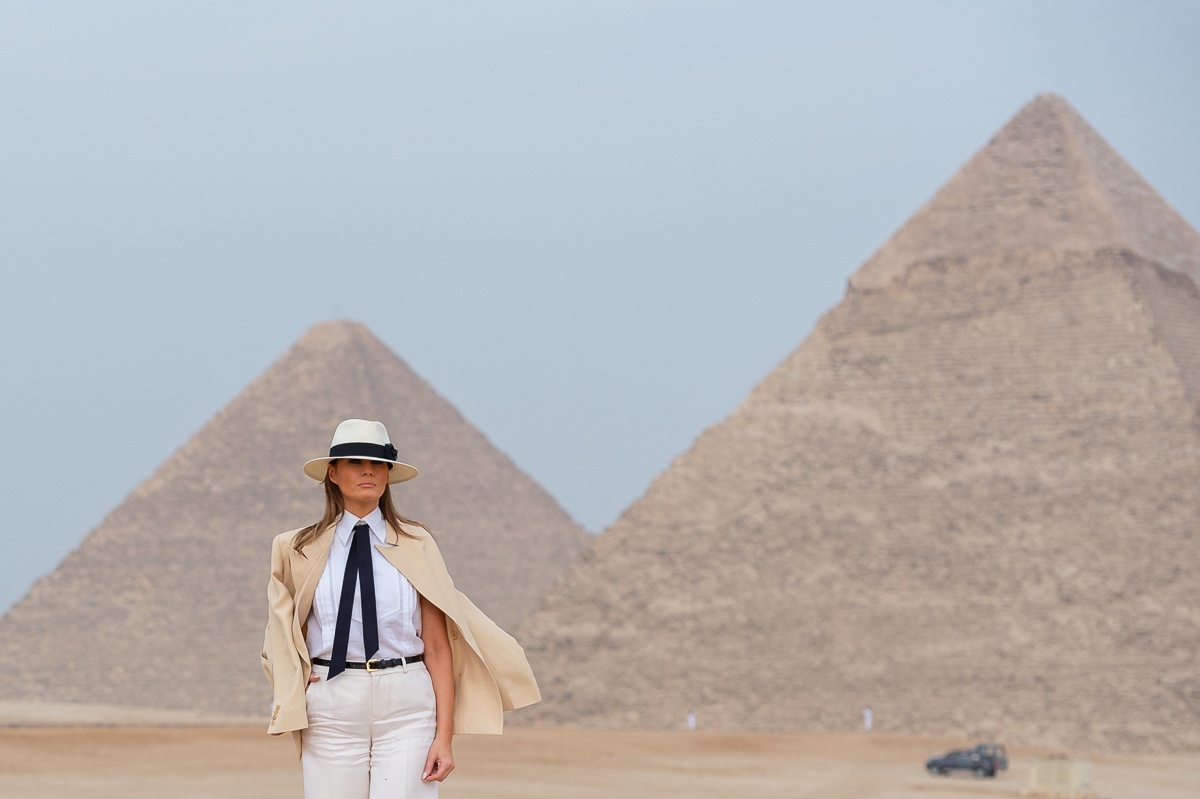SEEN & READ – BY ISABELLE GRAW Michael Asher, Melania Trump, Matthew Barney and Alex Katz

“Michael Asher”

“Michael Asher,” Artists Space, New York, 2024
This exhibition represents a welcome exception. For while New York’s galleries – whether in Chelsea, Tribeca, the Lower East Side, or Uptown – are all currently showing paintings that largely ignore the Conceptual Turn of the 1960s and 1970s, visitors to Artists Space are given a demonstration of the epistemological potential of Michael Asher’s situative aesthetic. The show focuses primarily on Asher’s lesser-known works, aided by a sober-seeming installation dominated by a series of vitrines and publications laid out on wide plywood plinths. I particularly want to mention Asher’s only private commission (Grinstein Collection, 1979), which he produced for a collector couple in Los Angeles. From today’s perspective, the work can be read as a blueprint for the infrastructural critique of contemporary artists such as Cameron Rowland. With the help of a lengthy and laborious legal agreement, Asher coerced the Grinsteins into moving a publicly visible section of the boundary wall of their property in such a way that it increased their neighbor’s share of the land while reducing their own. The Grinsteins thus had to accept a small and therefore largely symbolic loss of their property in order to then be rewarded with a sculptural work by Asher in return. The exhibition features a large printed photo wallpaper of the wall and its classicist columns, pictured alongside the trees of the neighboring property. Not only did Asher touch upon the sacrosanct law of ownership with this project, but he also forced an interaction between the collector couple and their neighbors, since the latter had to agree that the wall could be moved. Here, as is often the case in Rowland’s work, a critique of property is combined with an authoritarian gesture that pushes the clients to do something against their own interests. Another work by Asher (Corps de Garde, 1979), now appears almost prophetic, seemingly having paved the way for the network imperative of today: the artist placed an advertisement in a Dutch daily newspaper, offering readers the opportunity to have their own phone number printed on a T-shirt at a market stall in Groningen. The exhibition features one of these now yellowed T-shirts, with the six-digit telephone number of its wearer printed vertically on it in Futura Bold. The notion that fashion is an expression of individuality is simultaneously taken up and counteracted in this project. For while each T-shirt is individual to its wearer, the work also implies that entering into exchange with others reduces us to a number. This is even truer in the digital economy, of course, in which our sense of our own value is determined by the number of followers we have. A work composed of eight postcards with pictures of trucks, first shown by Asher at the Kunstverein in Hamburg in 1989, is also highly topical. For the New York show, the cards have been presented in plexiglass frames, as a sort of vertical mobile. The pictured trucks are transporting toxic waste from West Germany to East Germany – the GDR received a dividend for taking on the poisonous materials. With this work, Asher shows that every transaction has a winner and a loser. The motif of the lorries carrying their toxic loads also recalls the transactions of the art world, where goods are similarly transported across the world to the detriment of the environment.
A final word goes to Asher’s magnificent checkerboard work (Checkers, 1965/66), which adopts the aesthetic of Minimalist art in order to simultaneously take aim at it. These serial and uniformly round checkers pieces display the qualities of Minimalist objects, which are also serially produced and are often based on geometric forms. They also underline the strategic purpose of Minimalist art, which was similarly interested in fortifying its position and beating the competition (such as Abstract Expressionism and Pop Art). Here, once again, Asher borrows from a movement’s formal vocabulary while simultaneously demonstrating its seamier side.
Artists Space, New York, November 22, 2024–February 8, 2025.
Melania Trump, Melania: A Memoir

Melania Trump tours the site of the Giza Pyramids, Cairo, 2018
Coinciding with Donald Trump’s reelection in the United States, the memoirs of his wife, Melania Trump, have now been published. While this book has little to offer in literary terms, as a description of the mentality of well-off Trump supporters it is highly informative. Written in the flattened language of a ghostwriter, it presents Melania as a woman with no inner life, and who never shows any sign of doubt or self-criticism. Her life appears as a pure and uninterrupted success story. Even as a model, she portrays herself as extremely ambitious and well-organized; failure doesn’t seem to exist for her. The book also gives the impression that there were no other men in her life before Donald, as if he had been the only one. Nor is there any mention of the fact that the success of her jewelry and cosmetics line is largely due to her husband’s fame. Instead, media bashing forms a leitmotif running throughout this text, as Melania depicts herself as a victim of misrepresentations and rails against the “lying media,” without it ever occurring to her that she herself might have contributed to the less than flattering image that many in the media have painted of her. Instead, she spends multiple pages torturing her readers with minutely detailed descriptions of the renovations carried out at the White House under her supervision. As soon as there is mention of anything political, such as the Black Lives Matter protests, she instantly backtracks by appealing to us to remember what it is that unites us. It’s telling that the name George Floyd isn’t even mentioned, as if his racist murder had never happened. Like her husband, Melania Trump seems firmly convinced she’s always done everything right. She also comes across as fairly humorless, never laughing at herself and always seeing others as the problem. Her self-righteousness and incapacity for self-criticism seem as dangerous as her refusal to name societal problems for what they are. While she occasionally implies that she doesn’t agree with her husband’s brutal migration policies, she doesn’t go into detail, sticking to her mantra that we have to be tolerant of those with different opinions. According to her, the impeachment process against Trump is completely baseless. Ultimately, this book is depressing proof of the power of denial, and of the danger it presents to democracy.
New York: Skyhorse, 2024, 256 pages.
“Matthew Barney and Alex Katz: The Bitch”

“Matthew Barney and Alex Katz: The Bitch,” O’Flaherty’s, New York, 2024
A collaboration between the artists Matthew Barney and Alex Katz seems unlikely at first glance – their formal vocabularies and aesthetic references are too different. But in this exhibition at O’Flaherty’s – an experimental gallery run by the artist Jamian Juliano-Villani on the Lower East Side – the combination of the two artists proves to be both plausible and productive. Stepping into the gloomy and run-down entrance area of the gallery, you find yourself at a counter that Barney has upholstered all around with plastic padding. It appears as if the hard edges of this counter have been softened, as if all that is destructive were aesthetically sublimated here. Installed high up on a wall behind the counter is Barney’s three-channel video installation Drawing Restraint 28 (2024), which shows the now 97-year-old Katz at work. Above all, Barney’s video emphasizes the painter’s astoundingly athletic condition: we see him standing steadily on a high ladder, painting orange zones on his white canvases – and with a brush that appears to be somewhat too small for the areas to be filled. The results of this visibly corporeal process are on view in the upper floor of the gallery. Hanging there are three almost monochromatic landscape paintings whose glowing shades of orange recall the palette of the late work of Vincent van Gogh. In both their use of color and their stencil-like abstract formal vocabulary, these paintings herald a late phase for Katz, who primarily became known for his figurative portraits of members of New York society. Barney shows Katz in a new light, however, which is largely due to his video’s deliberately overamplified soundtrack: each movement of Katz’s brush produces a threateningly loud scratching and penetrating scraping, inevitably brining to mind the similarly distorted soundtrack to David Lynch’s stylized horror film Eraserhead (1977). Here, Barney uses acoustic means to exaggerate the abject and destructive aspect of painting to extreme levels. The film also contains short sequences that show his own process of production: we see Barney’s cameraman, as if his work was fusing with Katz’s. Just as the video functions as a tribute to Katz’s paintings, it can also be read as a transposition of his painterly vocabulary into Barney’s filmic aesthetic. An equally vital- and destructive-seeming bronze sculpture by Barney is on display in a rear room. Water Cast 10 (2015) resembles a burned tree trunk with two branches violently extending from it – an artistic reaction to a peculiarity of the exhibition space, whose entrance room always contains a tree. At the same time, Barney’s object refers to the informe objects produced by the ritual practice of throwing molten lead into water (a New Year’s Eve tradition in Germany). Barney’s bronze is the result of a laborious production process, which includes both moments of violent destruction and sublimation in aesthetic practice.
The upper room contains an even more explicit reference to painting by Barney: five buckets, stacked upon one another and covered with what seems to be a sticky white mass, making them unusable. Taken as a reference to the paint bucket, this functionless object uses the painterly dispositive to simultaneously call for us to “stop painting.” This exhibition makes it clear that destructive impulses and abject forces are at play within both Barney’s and Katz’s work, as well as forms of aesthetic sublimation. It’s also interesting to see that both works required a great deal of physical effort on the part of the still-athletic male artists.
O’Flaherty’s, New York, November 7–December 15, 2024.
Translated by Ben Caton
Isabelle Graw is the cofounder and publisher of TEXTE ZUR KUNST and teaches art history and theory at the Hochschule für Bildende Künste – Städelschule in Frankfurt am Main. Her most recent publications include In Another World: Notes, 2014–2017 (Sternberg Press, 2020), Three Cases of Value Reflection: Ponge, Whitten, Banksy (Sternberg Press, 2021), and On the Benefits of Friendship (Sternberg Press, 2023).
Image credit: 1. Photo Rob Kulisek; 2. Courtesy of Artists Space, New York and the Michael Asher Archive, Michael Asher Foundation, photo Carter Seddon; 3. Public domain; 4. Courtesy of O’Flaherty’s, photo David Regen
